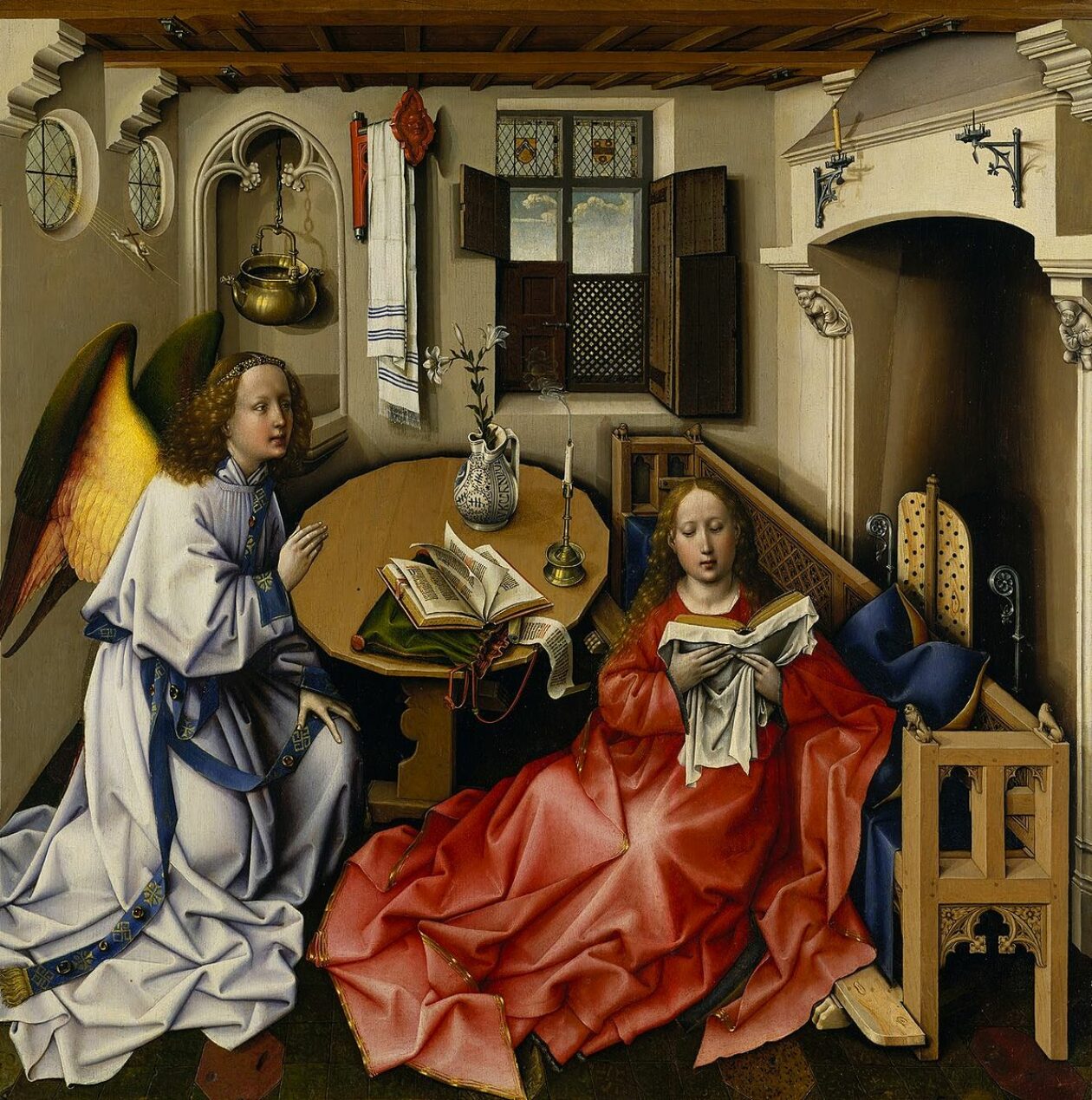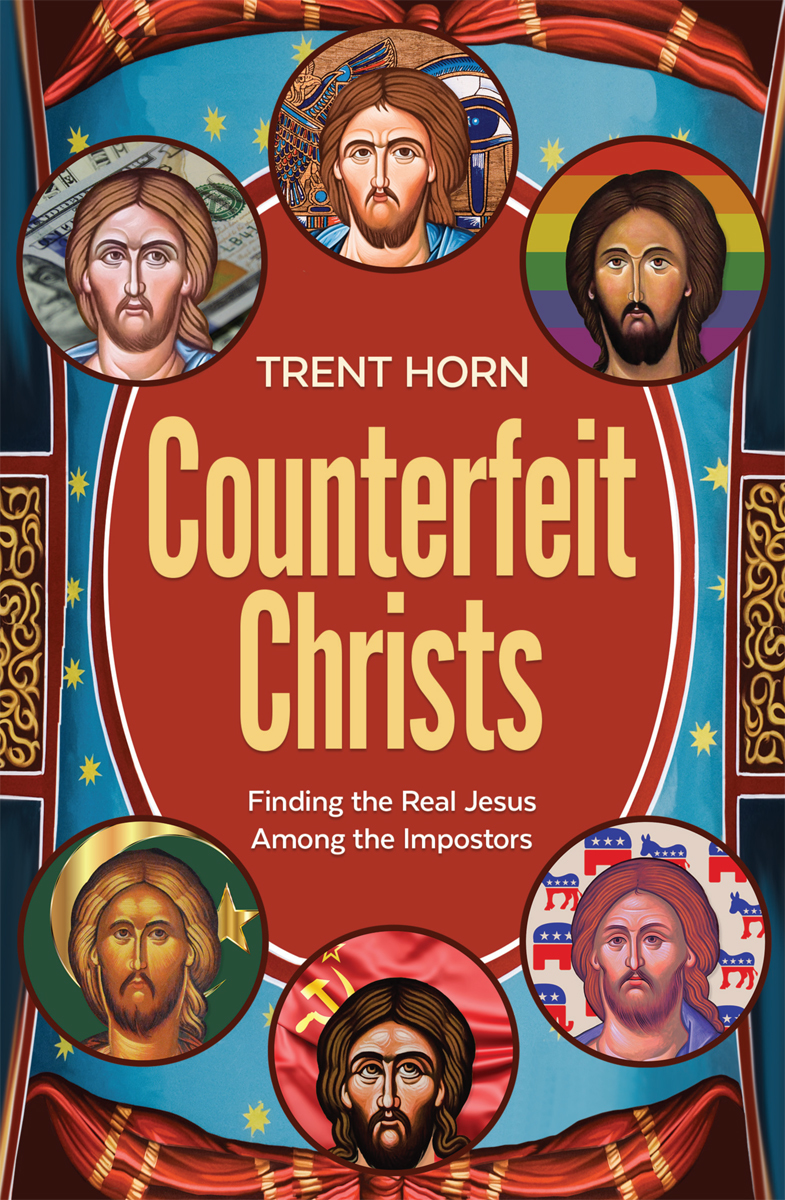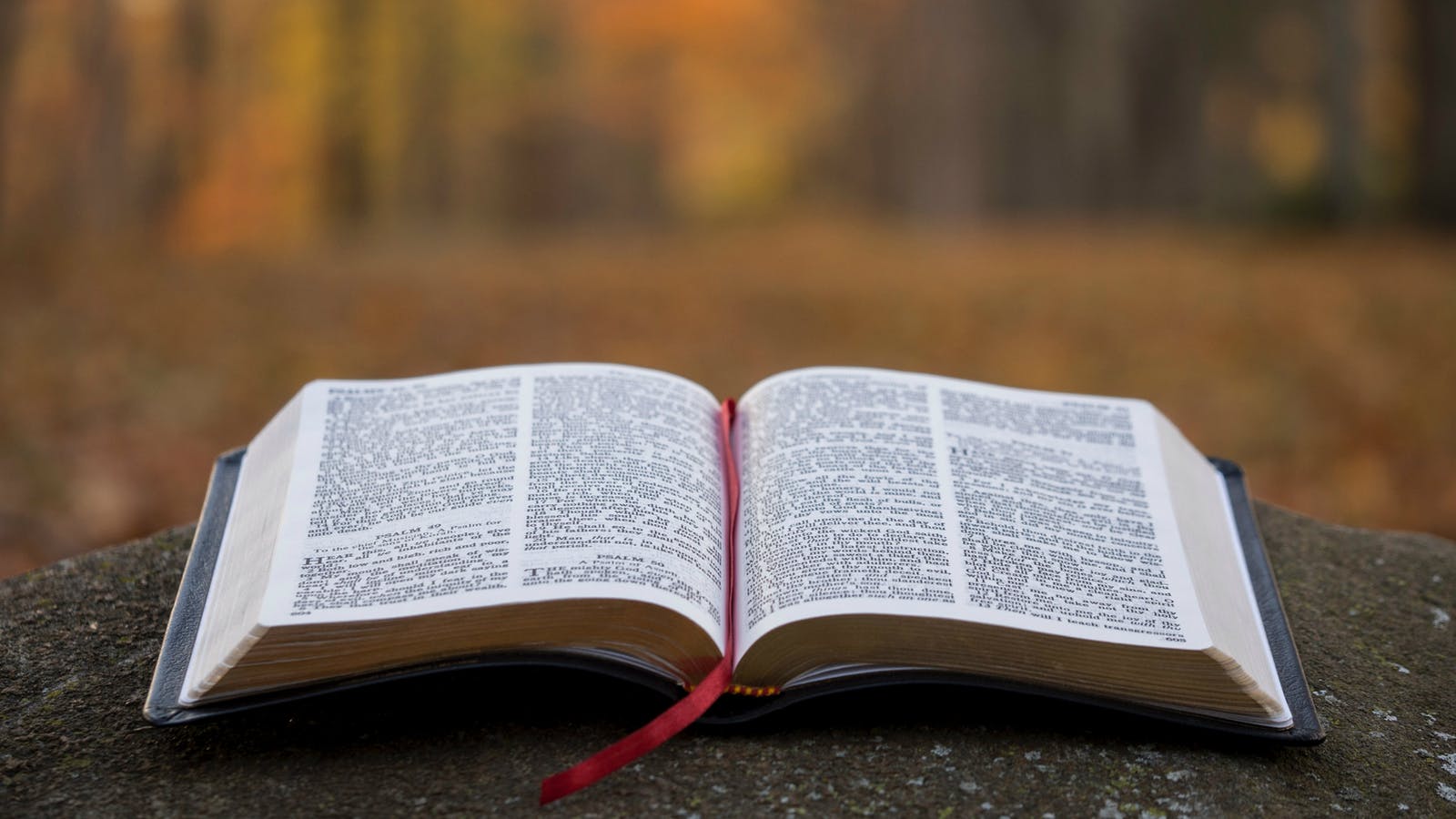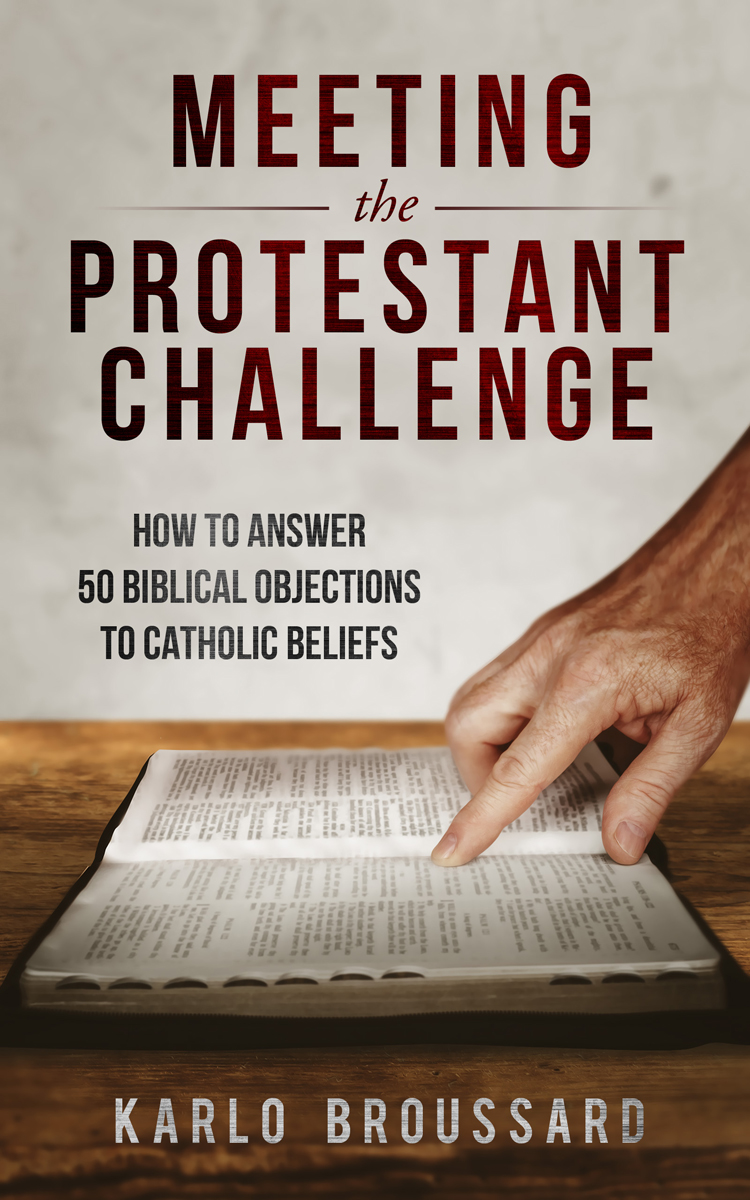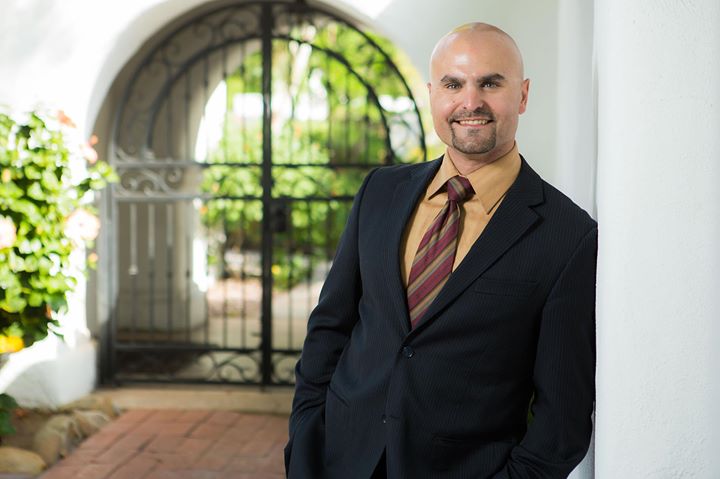
-“Forerunners of Christ with Saints and Marytrs”, Fiesole San Domenico Altarpiece, probably by Fra Angelico. Room 60, The National Gallery, London, UK. Please click on the image for greater detail.
These panels come from the predella (lowest part) of the altarpiece made for the high altar of San Domenico, Fiesole. Fra Angelico was a Dominican friar (a member of the religious order founded by Saint Dominic) as well as a painter. The church was attached to his own convent – so although he made two other altarpieces for it, he was not paid for his work.
Predellas usually showed narrative scenes of the lives of the saints who were depicted in the main part of the altarpiece. This one is unusual: it shows Christ in glory in heaven, surrounded in the central scene by angels. This is framed by two panels showing rows of saints and Old Testament figures. These in turn are enclosed on either side by Dominican ‘Blessed’ figures who were holy and revered but not saints.
The mass of saints includes Dominicans and reflects their interest in the saints of their order and the place of the Dominicans in the broader church.

–by Fr Mitch Pacwa, SJ,
“Most “Bible-believing” Christians object to the Catholic practice of praying to the saints. These critics worry that Catholics will go to hell for offending God with a neo-pagan system of worship. They have four main criticisms of the custom, all of which they push forward vigorously.
First, they accuse Catholics of worshipping Mary and the other saints. This violates the first commandment: “You shall not have any other gods before me” (Ex. 20:3).
Additional proof that Catholics worship the saints is that they make statues of them, in violation of the next commandment: “You shall not make for yourself an idol or any image which is in the heavens above or on the earth below or in the waters which are under the earth; you shall not bow down and serve them because I am the Lord your God” (Ex. 20:4-5). Catholics make statues of the saints whom they worship, thereby committing the double sin of polytheism and idolatry.
The second objection to praying to the saints is that, even if Catholics do not worship the saints, they are at least calling upon the spirits of the dead. Scripture explicitly forbids conjuring the dead in many passages:
“Do not turn to mediums and familiar spirits; do not seek defilement among them” (Lev. 19:31). “The soul who turns to mediums and to familiar spirits to go whoring after them, I will set my face against that soul and cut him off from the midst of his people” (Lev. 20:6). “The man or the woman who becomes a medium or a familiar spirit will surely die; they will cast stones at them; their blood will be on themselves” (Lev. 20:27). “Let there not be found among you one who makes his son or his daughter pass through fire, a diviner of divinations, an occultist, a charmer, an enchanter, one who casts spells, or one who questions mediums or familiar spirits, or one who seeks the dead” (Deut. 18:10-11). Since the saints are all dead, no one is allowed to consult them without breaking these biblical laws.
A third objection is that there is only one mediator with the Father, Jesus Christ. “For there is one God and one mediator between God and men, a man, Jesus Christ, who has given himself as a ransom for all, the testimony in its own time” (1 Tim. 2:5-6). Jesus Christ is fully satisfactory as the mediator between sinners and God. No one should ever ask the saints for intercession.
A fourth objection is that the Bible does not instruct Christians to honor the saints, seek their intercession, or keep their relics. Without any biblical injunction to perform these things, a Christian risks displeasing God.
The Catholic Church always has taught that a Christian can worship only God, Father, Son and Holy Spirit. No creature, no matter how good or beautiful–no angel, no saint, not even the Virgin Mary–deserves adoration.
This is the teaching of the creeds (Apostles’ Creed: “I believe in one God”; Nicene Creed: “We believe in one God”) and the catechisms (Baltimore Catechism, question 199: “By the first commandment we are commanded to offer to God alone the supreme worship that is due him”) and the Church councils (Nicaea, in 325; Rome in 382; Toledo in 675; Lateran IV in 1215; Lyons in 1274; Florence in 1442; Trent from 1545-1563; Vatican I from 1869-1870).
The Catholic Church condemns polytheism and idolatry alike. Pope Dionysius condemned the division of the one God into three gods, for there can be only one God, not three (Letter to Dionysius of Alexandria, A.D. 260). Pope Damasus I condemned the worship of other gods, angels, or archangels, even when God gave them the name of “god” in the Bible (Tome of Damasus, approved at the Council of Rome, 382).
John Damascene’s Apologetic Sermons Against Those Who Reject Sacred Images gives an authentic presentation of the Catholic attitude towards statues and pictures of Mary and the saints: “If we were making images of men and thought them gods and adored them as gods, certainly we would be impious. But we do not do any of these things.”
The Baltimore Catechism, question 223, confirms this by teaching: “We do not pray to the crucifix or to the images and relics of the saints, but to the persons they represent.”
Catholic doctrine absolutely rejects the worship of anyone but God and rejects all worship of statues, whether of Christ or the saints. What the Church does allow is praying to the saints in order to ask for their intercession with the one true God. The Church also allows one to make statues to remind a person of Christ or the saint:
“Further, the images of Christ, of the Virgin Mother of God, and of the other saints are to be kept with honor in places of worship especially; and to them due honor and veneration is to be paid–not because it is believed that there is any divinity or power intrinsic to them for which they are reverenced, nor because it is from them that something is sought, nor that a blind trust is to be attached to images as it once was by the Gentiles who placed their hope in idols (Ps. 135:15ff); but because the honor which is shown to them is referred to the prototypes which they represent.
“Thus it follows that through these images, which we kiss and before which we kneel and uncover our heads, we are adoring Christ and venerating the saints whose likenesses these images bear” (Council of Trent, Session XXV, Decree 2).
This mirrors the Old Testament attitude. Soon after they received the commandment prohibiting the making of images for worship, the Israelites were told by the Lord to “make two cherubim of beaten gold; you will make them for the two ends of the covering [of the Ark of the Covenant]” (Ex. 25:18). After many Israelites suffered punishment in the form of snakebite, at the Lord’s instruction “Moses made the bronze serpent and he set it upon a pole, and it happened that if a serpent bit a man, and he looked to the bronze serpent, he lived” (Num. 21:9).
The gold cherubim and the bronze serpent were not objects of worship. The cherubim symbolized the presence of God’s angels at the Ark of the Covenant, and the bronze serpent was God’s means of healing the people of poisonous snakebite. So too do Catholics make statues to represent the presence of the saints and angels in churches, homes, and elsewhere.
The Bible teaches that the attempt to contact the dead through seances and mediums is a serious sin. The Catholic Church, being a Bible-believing Church (actually, of course, it’s more than that–the Catholic Church is the one and only Bible-writing Church), condemns all forms of superstition and conjuring the dead.
The Baltimore Catechism explains the seriousness of the sin of superstition: “Superstition is by its nature a mortal sin, but it may be venial either when the matter is slight or when there is a lack of full consent to the act” (question 212).
When the Catholic Church encourages devotion and prayer to the saints, in no way does it intend for its members to practice some form of superstition. Never does the Church instruct the faithful to conjure the spirits of the saints to carry on some two-way communication. There are no seances that try to make them appear, speak messages, tap tables, or anything of the sort.
The faith of the Church is that the saints are not really dead, but are fully alive in Jesus Christ, Who is Life Itself (John 11:25; 14:6) and the bread of life who bestows life on all who eat His flesh and drink His blood (John 6:35, 48, 51, 53-56). The saints are alive in heaven because of the life they have received through their faith in Christ Jesus and through their eating of His body and blood.
The book of Revelation shows the saints worshipping God, singing hymns, playing instruments, making requests to Christ to avenge their martyrdom, and offering prayers for the saints on earth (Rev. 4:10, 5:8, 6:9-11).
Because they are alive, we believe that we can go to them to intercede for us with God. We do not need to see apparitions or hear their voices in order to believe they will pray for us in heaven. We trust that the saints will accept our requests for help and will present them to Christ for us.
The Catholic Church has always believed that Jesus Christ is the one mediator between God and man. It is the death and resurrection of Jesus alone by which people are saved.
In 449 AD Pope Leo the Great wrote his Tome against Eutyches, who taught that Jesus Christ had only one nature, not two. (This was the heresy of monophysitism.) In the Tome, which the Council of Chalcedon accepted as the authentic Catholic teaching on Christ, he quotes 1 Timothy 2:5 as the authentic Catholic doctrine: “Hence, as was suitable for the alleviation of our distress, one and the same mediator between God and men, Himself man, Christ Jesus, was both mortal and immortal under different aspects.”
The fifth session of the Council of Trent (1546) laid out the belief in Jesus the one true mediator as the norm of Catholic faith: “[Original sin cannot be] taken away through the powers of human nature or through a remedy other than the merit of the One Mediator, our Lord Jesus Christ, Who reconciled us to God in His blood, having become our justice, and sanctification, and redemption.”
The schema of the Dogmatic Constitution on the Principal Mysteries of the Faith, drafted for the First Vatican Council (1869-1870), includes the unique mediation of Jesus Christ as one of these principal mysteries: “Truly, therefore, Christ Jesus is mediator between God and man, One man dying for all; He made satisfaction to the divine justice for us, and He erased the handwriting that was against us. Despoiling principalities and powers, He brought us from our longstanding slavery into the freedom of sons.”
These quotations from official Catholic documents give unambiguous proof that the Church believes Jesus Christ and no other is the one mediator between sinful humanity and the righteous God. How does the Church integrate this essential doctrine of the faith with the belief that we can pray to the saints?
First, God expects us to pray for one another. We see this in both the Old and New Testaments.
In a dream, God commanded King Abimelech to ask Abraham to intercede for him: “For [Abraham] is a prophet and he will pray for you, so you shall live” (Gen. 20:7). When the Lord is angry with Job’s friends because they did not speak rightly about God, he tells them, “Let my servant Job pray for you because I will accept his [prayer], lest I make a terror on you” (Job 42:8).
Paul wrote to the Romans: “I exhort you, brothers, through our Lord Jesus Christ and through the love of the Spirit, to strive with me in prayers to God on my behalf, that I may be delivered from the disobedient in Judaea and that my ministry may be acceptable to the saints in Jerusalem, so that in the joy coming to you through the will of God I may rest with you” (Rom. 15:30-32).
James says: “Therefore confess your sins to one another, and pray for one another, that you may be healed. The prayer of a righteous man has great power in its effects” (James 5:16-17). Thus, according to Scripture, God wants us to pray for one another. This must mean that prayer for one another cannot detract from the role of Jesus Christ as our one mediator with God.
Second, the reason that Christians have the power to pray for one another is that each person who is baptized is made a member of the Body of Christ by virtue of the Holy Spirit’s action in baptism (1 Cor. 12:11-13). It is because the Christian belongs to Jesus Christ and is a member of his Body, the Church, that we can make effective prayer.
The reason we pray to the saints is that they are still members of the Body of Christ. Remember, the life which Christ gives is eternal life; therefore, every Christian who has died in Christ is forever a member of the Body of Christ. This is the doctrine which we call the Communion of the Saints. Everyone in Christ, whether living or dead, belongs to the Body of Christ.
From this it follows that a saint in heaven may intercede for other people because he still is a member of the Body of Christ. Because of this membership in Christ, under his headship, the intercession of the saints cannot be a rival to Christ’s mediation; it is one with the mediation of Christ, to whom and in whom the saints form one body.
Some Christians–most Protestants, in fact–deny that the Bible gives support for devotion to the saints, but they are incorrect. The Bible encourages Christians to approach the saints in heaven, just as they approach God the Father and Jesus Christ the Lord: “But you have approached Mount Zion, the city of the living God, the heavenly Jerusalem, and myriads of angels, and the assembly and church of the firstborn who have been enrolled in heaven, and God the judge of all, and spirits of righteous ones who have been made perfect, and Jesus, the mediator of a new covenant, and the sprinkled blood which speaks better than that of Abel” (Heb. 12:22-24).
It is clear the Christian has approached a number of heavenly beings: the heavenly Jerusalem, the angels, God the judge, and Jesus the mediator. “The assembly and church of the firstborn who have been enrolled in heaven” and the phrase “spirits of righteous ones who have been made perfect” can refer only to the saints in heaven.
First, they are spirits, not flesh and blood. Second, they are righteous people, presumably made righteous by Jesus Christ, “who is our righteousness.” Third, they have been made perfect. The only place where spirits of perfected righteous people can dwell is heaven.
Furthermore, “spirits of righteous ones who have been made perfect” is a perfect definition of the saints in heaven. This passage is saying that, just as Christians approach the angels, God the judge, Jesus Christ, and his saving blood, so also must we approach the saints in heaven.
Does the Bible say we should approach the saints with our prayers? Yes, in two places. In Revelation 5:8 John saw the Lamb, Christ Jesus, on a throne in the midst of four beasts and 24 elders. When the Lamb took the book with the seven seals, the 24 elders fell down before the Lamb in worship, “each one having a harp and golden bowls of incenses, which are the prayers of the saints.”
Similarly, in Revelation 8:3-4 we are told that something similar happened when the Lamb opened the seventh seal of the book: “Another angel came and stood on the altar, having a golden censer, and many incenses were given to him, in order that he will give it with the prayers of all the saints on the golden altar before the throne. And the smoke of the incenses went up with the prayers of the saints from the hand of the angel before God.”
These texts give us a way to understand how the saints offer our prayers for us. Our prayers are like nuggets of incense. They smell sweet and good. The 24 elders around the throne, who are saints, and the angels offer these nuggets of incense for us. They set them on fire before the throne of God.
This is a beautiful image of how the intercession of the saints works. Because the saints are so close to the fire of God’s love and because they stand immediately before him, they can set our prayers on fire with their love and release the power of our prayers.”
Love, & the joy of the saints,
Matthew
